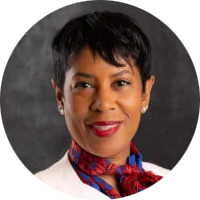
Months after the June 2023 US Supreme Court ruling on the constitutionality of race-based affirmative action in university and college admissions, companies are still struggling with what this means for corporate diversity practices. Catalyst hosted a webinar with two DEI experts—Josetta Jones, Chief Diversity and Inclusion Officer at Chevron, and David Glasgow, Executive Director, Meltzer Center for Diversity, Inclusion, and Belonging at NYU School of Law. We wanted to know: How will this decision affect the DEI initiatives of corporate workplaces? What must companies do to ensure their DEI initiatives are protected and sustained?
We continue the conversation with questions submitted by webinar participants.
Disclaimer: This blog post is not a substitute for professional legal advice. If you want guidance on what, if any, impact this ruling will have on your own organization’s specific DEI practices, please seek advice from your legal counsel.

Josetta Jones, Chief Diversity and Inclusion Officer at Chevron

David Glasgow, Executive Director of NYU Law’s Meltzer Center for Diversity, Inclusion, and Belonging
How might this decision impact a company’s ability to collect, track, and use race/ethnicity when analyzing talent data for systemic inequalities?
Josetta Jones: Although there hasn’t been a decision directed at corporations, what we can say is that advancing diversity and inclusion initiatives aligns with the core values of The Chevron Way and our goal to improve lives, create opportunity, and power the world forward. We’re committed to expanding the diversity of our workforce and promoting greater inclusion to deliver ever-cleaner energy to the world.
David Glasgow: I don’t see a problem with collecting and tracking data; in fact, some data collection is necessary for reporting purposes, such as for the EEO-1 Report that many organizations are required to submit to the Equal Employment Opportunity Commission. What is prohibited is using data to make decisions that involve discrimination on the basis of a protected category, such as race. For example, if you collect data showing that certain racial or ethnic groups are lagging in promotion rates, it would be fine to use that information to improve your promotion processes by ensuring that the criteria for advancement are clear, transparent, and merit-based, and that decision-makers are trained in how to mitigate implicit bias. On the other hand, if you use the data to create a leadership development program reserved only for certain racial or ethnic groups, that use would involve legal risk.
In the DEI industry, it is known that setting goals by gender and race is the best practice to move the needle toward representation for women and people of color. Should we still do this, or should we move away from this practice?
David Glasgow: This is a gray area, but I think there is a solid legal argument to distinguish between purely aspirational goals and impermissible discrimination on the basis of race or sex. For example, in an Eleventh Circuit Court of Appeals decision called Denney v. City of Albany (2001), the court noted that “[t]he setting of goals for minority hiring or promotion can be lawful,” especially where—as in that case—the employer also had a policy expressly stating that personnel decisions must be made without regard to factors such as race. Whether the current conservative Supreme Court would agree with that distinction is not clear, but there is at least a decent legal argument.
Goals become particularly risky when there are carrots and sticks attached to the goals that incentivize managers to make employment decisions based on race or sex—for example, when a company gives bumps in a performance evaluation process or financial bonuses to managers who achieve certain diversity goals. If you decide to continue using goals, I would suggest making sure they are described in broad aspirational terms and always accompanied by a commitment to making employment decisions (such as hiring and promotion) based on qualifications and merit alone.
How is Chevron dealing with challenge?
Josetta Jones: We don’t have quotas for hiring. Our people strategy takes into account that everyone’s life experiences are varied. We recognize that we must find talent from many places, including schools and organizations that attract underrepresented talent. We should strive to find new employees from a variety of schools, organizations, and places where we may not have traditionally recruited.
If hiring decisions cannot be race-based, what about ensuring a racially diverse slate of candidates?
David Glasgow: Ensuring a racially diverse slate of candidates is certainly less risky than making actual hiring decisions based on race, because employers can argue that they are not discriminating against anyone—they are simply expanding the pool of qualified candidates before making the ultimate decision based on merit. That being said, anti-DEI activists may challenge diverse slate requirements at some stage. A key question for courts will be: Does adding candidates to a hiring pool based on race cause legally cognizable harm to others, such as because it dilutes the hiring prospects of the other candidates? I support the continuation of diverse slate requirements because they are an extremely important tool for expanding opportunity, but I am watching this space closely.
What is Chevron doing in this situation?
Josetta Jones: Chevron has made efforts to create positive work environments long before developing a diversity and inclusion sector. We understand that making employees feel safe, seen, valued, and respected helps foster diversity which, in turn, fosters creativity. Therefore, we are ensuring a positive, diverse, and creative space by opening all opportunities to a variety of candidates.
If we have data showing that a demographic is lagging behind in performance scores, or is less likely to be selected for development programs, may we implement a program to address those gaps?
David Glasgow: It depends on what the program is. If you create a program (e.g., a sponsorship initiative) but only members of certain racial groups are eligible to participate, I consider that to be risky. Whereas if you create a program that is open to everybody, but you expect it to benefit members of disadvantaged demographic groups more, that is fine. For example, you could create a program that is open to applicants “with a demonstrated commitment to diversity and inclusion,” or you could establish initiatives that benefit the entire workplace (such as skill-building sessions on allyship or inclusive leadership).
How is Chevron addressing this issue so far?
Josetta Jones: In most circumstances, collected data is meant to help us better understand our efforts, but this data cannot always give a perfect idea of our effectiveness. Creating these opportunities and developing programs to address such issues is important in progressing inclusion. These demographics could begin to see less involvement due to such data, therefore possibly leading to less representation in that space and inadvertently creating a much less diverse environment. By addressing those gaps through seeking employees from many places, our programming shows support, provides resources, and ensures that all groups are welcome to participate and grow. Chevron is focused on fostering a workplace where our employees and contractors feel included and that they belong. We know that when our employees are psychologically and physically safe, then we can unlock the full potential of our workforce.
Are differentiated programs (providing different support for different affinities) at risk?
Josetta Jones: Chevron recognizes the importance of having diversity in our employees and talent and will always strive to remain a workplace which fosters innovation and creativity. We periodically look for opportunities to reassess and redesign, as needed, our DEI programs to improve performance and address any perceived inequities. It’s important to remember these programs are not intended to be used as a requisite for hiring, but rather to further grow the capabilities of our employees.
David Glasgow: If you have different affinity groups for different demographics (such as a Black employees’ network and a women’s network), that is fine in and of itself. The same goes for hosting different events or activities, such as programs marking Asian American and Pacific Islander Heritage Month or LGBTQ Pride Month. Risks arise, however, if you offer differentiated support that affects people’s employment opportunities—for example, a training program in which employees must belong to a particular racial group to participate.
###
Read the Catalyst statement on the US Supreme Court decision on affirmative action.
Read our Q&A with legal experts Kenji Yoshino and David Glasgow on the decision.
Is your company a Catalyst Supporter? Watch the Supporter-exclusive webinar with Josetta Jones and David Glasgow. Not yet a Supporter? Learn more to join the Catalyst community.




![What Is An Alternative Education Program? Preparing Students For The Future [2024 DEI Resources]](https://diversity.social/wp-content/uploads/2023/01/Best-employers-for-Family-friendly-diversity-certification.png)
